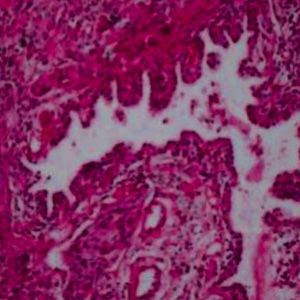Subtyping of advanced lung cancer based on PD-L1 expression, tumor histopathology and mutation burden (EGFR and KRAS): a study from North India

Accepted: December 13, 2022
All claims expressed in this article are solely those of the authors and do not necessarily represent those of their affiliated organizations, or those of the publisher, the editors and the reviewers. Any product that may be evaluated in this article or claim that may be made by its manufacturer is not guaranteed or endorsed by the publisher.
Authors
Immune checkpoint inhibitor (PD-L1) therapy of advanced non-small-cell lung cancer (NSCLC) has variable outcomes. Tumor subtypes based on PD-L1 expression, histopathology, mutation burden is required for patient stratification and formulation of treatment guidelines. Lung cancers (n=57) diagnosed at Pathology department, VPCI (2018-2021) were retrospectively analyzed. PD-L1(SP263) expressed by tumor cells [low (<1%), medium (1-49%), high (≥50%)] was correlated with histopathology, microenvironment, EGFR, KRAS expression. Patients were categorized into high and low risk based on their: i) gender: males (n=47, 30-89 years), females (n=10, 45-80 years); ii) smoking history: males 26/47 (45.61%), females 1/10 (10%); iii) tumor subtyping: squamous cell carcinoma 15/57 (26.32%), adenocarcinoma 6/57 (17.54%), NSCLC-undifferentiated 24/57 (42.10%), adenosquamous carcinoma 5/57 (8.77 %), carcinosarcoma 4/57 (7.02%), small cell carcinoma 1/57 (1.75%); iv) inflammatory tumor microenvironment/TILs 44/57 (77.1%); iv) PD-L1 positivity-31/57 (54.3%); v) concomitant EGFR/KRAS positivity. PD-L1positive cases showed squamous/undifferentiated histopathology, concomitant EGFR+ (9/20, 45%) and KRAS+ (8/15, 53.3%), smoking+ (21/31,67.74%).PD-L1 negative cases (26/57, 45.6%), were EGFR+ (2/14, 14.28%) and KRAS+ (6/19, 31.5%). The high-risk lung cancer subtypes show squamous/undifferentiated histopathology, inflammatory microenvironment, male preponderance, smoking history, higher concomitant PD-L1, KRAS and EGFR positivity. Lung cancer subtyping can predict clinical response/resistance of patients prior to initiation of PD-L1 inhibitor therapies and can be used to guide therapy.
Supporting Agencies
The intramural funding was provided by Vallabhbhai Patel Chest Institute, University of DelhiHow to Cite

This work is licensed under a Creative Commons Attribution-NonCommercial 4.0 International License.
PAGEPress has chosen to apply the Creative Commons Attribution NonCommercial 4.0 International License (CC BY-NC 4.0) to all manuscripts to be published.
Similar Articles
- Andrea Segreti, Sara Mastroberardino, Lorenzo Frau, Alessandro Appetecchia, Luca D’Antonio, Danilo Ricciardi, Gian Paolo Ussia, Francesco Grigioni, Severe heart failure and intracardiac thrombosis: going beyond the appearance for diagnosis and treatments , Monaldi Archives for Chest Disease: Early Access
- Princy Domnic Dsouza, Sai Phalguna Prakash Chitralu, Chandrashekhar Mallikarjun Patil, Vinod Ashok Koujalagi, Sanatkumar Bharamu Nyamagoud, Prescription patterns and drug utilization in respiratory tract infections: implications for antimicrobial stewardship at a tertiary care teaching hospital , Monaldi Archives for Chest Disease: Early Access
You may also start an advanced similarity search for this article.

 https://doi.org/10.4081/monaldi.2023.2449
https://doi.org/10.4081/monaldi.2023.2449




